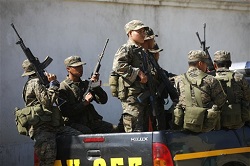A new report indicates that Central American states have increasingly relied on the military to fight crime with help from the United States, a decision which may bear consequences for human rights and levels of violence within the young democracies.
The Costa Rica based State of the Nation Program (Programa Estado de la Nación – PEN) presented its most recent regional study on the political, social and economic situations of Central American countries in Managua last week.
The 5th Report on the Regional State of Human Development (Quinto Informe Estado de la Región en Desarrollo Humano) — which was previously disclosed in Guatemala at the beginning of August and in Costa Rica at the start of September — reveals the extent of the militarization process in the fight against crime, a regional trend which is particularly strong in Guatemala, Honduras, El Salvador and Nicaragua.
According to the 436-page report, the size of the military increased by more than 50 percent in three of the four above-mentioned countries between 2008 and 2014. Guatemala takes the lead with 57.3 percent military growth during that period, followed closely by Honduras and El Salvador, with 51.5 and 50.9 percent respectively.
The militarization process was in large part enabled by US financial support provided under the banner of fighting organized crime. Out of the total $768 million of military and police assistance donated by Washington between 2004 and 2014 to Central America, $410 million was introduced at a regional level through mechanisms such as the Central American Integration System, while the rest was donated directly, in particular the Northern Triangle countries of El Salvador, Guatemala and Honduras. Guatemala comes first once again with a total of $132 million in US military aid.
Washington’s role in the militarization process extends beyond financing. According to the report, the US sold more than $2 billion worth of military weapons and equipment to Central America during that same ten-year period, between 2004 and 2014. Honduras’ accounted for $1.5 billion, or over 75 percent of the total.
Beyond the figures, the report points out that militarization can also be seen through the extension of the military’s mandate in these countries. Governments have increasingly used the military for internal security objectives and in order to maintain social stability. For example, El Salvador witnessed 11 executive decrees between 2003 and 2013 which allowed the army to participate in police operations.
The PEN report also points with alarm to the increasing partisanship of Nicaragua’s military and President Daniel Ortega’s attempt to gain greater control of the more politicized armed forces.
The authors of the report sum up this pattern by arguing that “the fight against crime and drug trafficking has paved the way for militarization in areas of public safety.”
InSight Crime Analysis
Militarization of the fight against organized crime in Central America has to be considered within the context of young democracies attempting — and in large part failing — to fortify their justice and law enforcement institutions.
For Northern Triangle states, strong criminal structures constitute a direct threat to democracy due to the widespread corruption, violence and significant economic costs that come with them. These states are steadily working towards creating efficient police and judicial bodies, as seen by Honduras’ police purge or Guatemala’s efforts with the United Nations-backed anticorruption body CICIG.
However, non-military institutions have generally failed to rein in crime and violence to acceptable levels, prompting governments fall back on the military to combat organized crime. This political decision is often facilitated by the general public’s view of the army as a less corrupt and more effective institution.
Contrary to these common perceptions, soldiers are no less immune to illicit financial incentives. This is especially true when they are moved to the frontline in the struggle against organized crime, where police and judicial bodies have been discredited. Examples of military operatives being corrupted include Venezuela’s “Cartel of Suns,” a network of military officers involved in drug trafficking, and Mexico’s notoriously violent Zetas Cartel, former special forces who left the military to work for drug cartels and eventually formed a cartel of their own. Central American examples include links between members of the Guatemalan military and criminal structures.
SEE ALSO: Mexico News and Profile
Another justification for a militarized response to organized crime is the increased capacity and militarization of criminal structures, which often can outgun and outmaneuver the police. While it is true that criminal groups are gaining easier access to more lethal weapons, repeated confrontations with the military may constitute a strong incentive for them to do so.
In El Salvador, gangs have reportedly acquired more assault rifles and sought military training in response to a militarized government crackdown on them.
Beyond the considerable risk of soldiers being corrupted, militarization of crime fighting without strong institutional safeguards can actually fuel violence. Soldiers — with the notable exception of members of “gendarmeries” — are neither trained nor equipped to apprehend criminals. They train to kill the enemy. Having soldiers on the streets has proved counterproductive in terms of respect for human rights as well as homicide rates.

